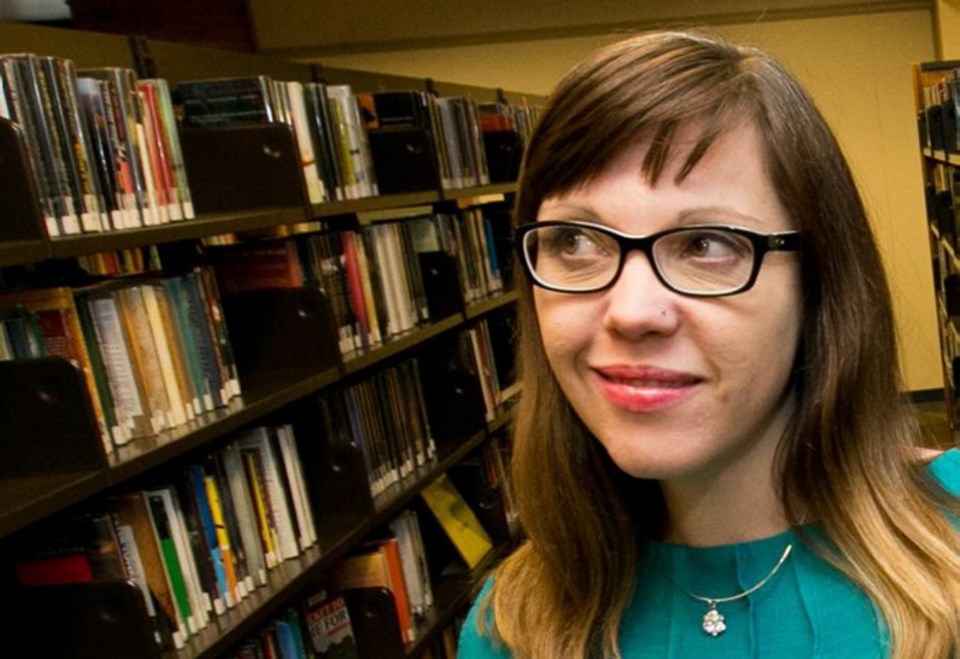Teenager Megan Sorensen, an advanced and avid reader, has rarely been cautioned about books, with one notable exception: The Diary of Anne Frank.
Megan, now 14, said she was in Grade 5 and went to her mother about Anne Frank, who asked if she was sure. When the girl insisted, her mother said, fine, but insisted they would read it together.
The young, Jewish Anne Frank’s two-year diary, written while her family hid during the Second World War, is one of the few books that has ever made Megan cry. To this day, the Holocaust has left a searing impression.
“Whenever I hear people making stupid jokes about it, I won’t just sit there and shake my head,” the Reynold’s Secondary School student said last week. “I will go up to them and say: ‘How could you?’ ”
Her mother, Donna Sorensen, remembers the Anne Frank moment as just one of the many, many books Megan has read. To this day, there is no book that’s off-limits, be it history, murder mysteries or horror (Megan’s current favourite genre.)
“There is some nasty stuff happening out there in the world and I don’t think sheltering teens is going to do them any good for the future,” said Donna.
But she said it has long been important for her and husband Perry always to be available and willing to talk about any book Megan might read.
“We have a very open question in our house and [Megan] has always just come to us and asked,” said Donna.
Books and movies — most recently The Hunger Games with its depiction of a barren, ugly future where teenagers are drafted to fight to the death in a kind of reality-TV mass entertainment — have sparked a discussion on violence for young people.
Plug “Hunger Games” and “violent” into a computer search engine and you will find stories from around the world with headlines such as “Hunger Games: Too Violent?”
But according to Michelle Ann Abate, Ohio State University professor of children’s literature and author of a recent 2013 book, Bloody Murder: The Homicide Tradition in Children’s Literature, none of the violence steeped in stories for young people should shock anyone.
Fairy tales collected and written by the Brothers Grimm in the 19th century, for example, were originally adult folk tales and filled with violence.
Little Red Riding Hood and her grandmother get swallowed by the Big Bad Wolf. They are only saved when the heroic woodsman cuts open the Wolf’s belly to release them. It’s pretty gruesome stuff.
The stepmother abuses Cinderella. And Snow White, in the original tale, endures being murdered three times.
“There’s a few moments where the Grimms left the violence either wholly untouched or they even amped it up a bit when they were adjusting the stories for young readers,” said Abate in a telephone interview.
She said she finds it ironic the Grimms would be so cavalier with the violence, but actually deleted certain bawdy, sexual references from the folk tales.
Even the Bible, often some of the first stories children will encounter, has its own violent, murderous moments. In the first book, Adam’s son Cain kills his brother Abel, for example.
Everyday life also contains violence or upsetting moments for kids. Many children grow up in tough neighbourhoods. They have siblings in the armed forces serving overseas. Or they are dealing with the aftermath of traffic accidents or the natural death of elderly relatives.
“When I hear the rhetoric about the Hunger Games or the later Harry Potter books, there is a sense that children should never experience fear or anxiety and never experience anything that is potentially upsetting,” said Abate.
“That seems very out of step with reality,” she said. “The world is filled with scary things and unfortunate experiences.”
And as entertainment goes, being frightened or horrified can be as fascinating for children as it is for adults.
“Young people are often drawn to stories that are morbid or gory, just like adults are,” said Abate.
She added, though, that it’s essential for parents to be available to talk with a young person after exposure to disturbing literature or entertainment, just as Donna and Megan did with Anne Frank.
“It can be very upsetting in cases where a young person is encountering these things solo, without a critical dialogue, without a chance to express their thoughts or concerns about what they have read,” said Abate.
“Having that dialogue, having that conversation is especially important,” she said. “It’s critical.”
Tracy Kendrick, children and teen services co-ordinator for the Greater Victoria Public Library, said the library doesn’t attempt to censor books for young people.
But Kendrick said a lot of care is taken to separate books into appropriate age categories.
The Greater Victoria Public Library, for example, separates the seven-part Harry Potter series. When it gets to book four and the themes become darker, the books are bumped up into young adult from the children’s section.
But Kendrick said her experience suggests young readers are often their own best censors. If they encounter something they don’t understand or don’t like or find too upsetting, they put it down.
“Just like an adult will say ‘Ugh, this is too gruesome, I can’t read this,’ a child will do the same,” said Kendrick. “I think we can trust our kids.”
And, like Abate and the Sorensens, Kendrick is a strong proponent of parents reading and discussing the books their children read.
“It’s good for a child’s emotional development,” said Kendrick. “It can really help the child process what they’ve read. And it can be a really enriching, bonding experience for parents and their kids.”
For those who wish to read Abate’s book, the Greater Victoria Public Library has ordered it.



